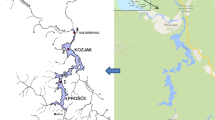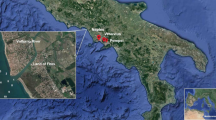Summary
The distribution of polychlorinated biphenyls (PCB) and organochlorine pesticides, e.g. the isomers of hexachlorocyclohexane (HCH), hexachlorobenzene (HCB), p,p’-dichiorodiphenyitrichloroethane (DDT) and its primary metabolites DDE and DDD was investigated in surface sediments (0–2 cm) and sediment cores (0–45 cm) from the western Baltic Sea and the coastal waters of Mecklenburg-Vorpommern. Sediment sampling was carried out in the Belt Sea, the Arkona Basin, the Pomeranian Bight and in almost all Bodden and Haff areas of Mecklenburg-Vorpommern in autumn 1993 and 1994. The highest concentrations of PCB and DDT compounds, measured in the innercoastal waters, reached 214 ng g-1 dry weight (d. w.). The values of HCH isomers ranged between 0.01 and 2.9 ng g-1 d.w., the highest levels being those of Β-HCH.
Levels of chlorinated hydrocarbons, which varied depending on the sediment properties, indicated increased riverine inputs (Oder, Peene, and Uecker). Elevated levels in the Oderhaff and Peenestrom characterize that area as a sink and, due to remobilization of the upper sediment layer (fluffy layer) into the pelagic, also as a source of organic contaminants. Input from agriculture and industrial point sources (shipyards, shipbuilding) was observed in the coastal waters. The homogeneous PCB and DDT distribution (TOC standardization) observed in the surface sediments of some areas in the western Baltic indicates high sediment dynamics. This is supported by the results of sediment core analyses which showed a constant PCB and DDT distribution down to a depth of 15 to 20 cm.
Zusammenfassung
Die Verteilungen von polychlorierten Biphenylen (PCB) und Organochlorpestiziden (DDT, HCH und HCB) wurden in OberflÄchensedimenten (0–2 cm) und in Sedimentkernen (0–45 cm) der westlichen Ostsee und der KüstengewÄsser Mecklenburg-Vorpommerns untersucht. Die Sedimentprobenahme erfolgte in der Beltsee, der Arkonasee, der Pommerschen Bucht und in nahezu allen Bodden-und HaffgewÄssern Mecklenburg-Vorpommerns im Herbst 1994 und 1995. Die höchsten Konzentrationen wurden für die PCB-und DDT-Verbindungen bis 214 ng g-1 Trockenmasse (TM) in den KüstengewÄssern gemessen. Für die HCH-Isomeren lagen die Werte zwischen 0,01 und 2,9 ng g-1 TM, mit höchsten Konzentrationen für das Β-HCH.
Die Werte der chlorierten Kohlenwasserstoffe (CKW) variieren nach der Sedimentbeschaffenheit und weisen auf erhöhte EintrÄge über die Flu\systeme (Oder und Peene) hin. Die höheren Konzentrationen in den Bodden-und HaffgewÄssern charakterisieren diese Gebiete als Senke und durch erneute Mobilisierung der oberen Sedimentschicht in das Pelagial auch als Quelle für die organischen Schadstoffe. Insbesondere konnten die EintrÄge aus der Landwirtschaft und aus industriellen Punktquellen (Werftstandorte, Schiffbau) in den KüstengewÄssern festgestellt werden.
Die nahezu homogene PCB-und DDT-Verteilung im OberflÄchensediment der westlichen Ostsee ist ein Hinweis auf die hohe Sedimentdynamik in diesem Gebiet. Dieses wird durch die Ergebnisse der Untersuchungen an Sedimentkernen unterstützt, die eine konstante PCB-und DDT-Verteilung bis zu einer Tiefe von 15 bis 20 cm zeigten.
Similar content being viewed by others

References
Ahlborg, U. G., G. C. Becking, L. S. Birnbaum, A. Brouwer, J. G. M. Derks, M. Feeley, G. Golar, A. Hanberg, J. C. Larsen, A. K. D. Liem, S. H. Safe, C. Schlatter, F. Woern, M. Younes, andE. YrjÄnheikki, 1994; Toxic Equivalency Factors for dioxin-Iike PCBs,Chemosphere 28, 1049–1067.
Andrulewics, E.,A. Brzezinska andA. Trzosinska, 1979: Some aspects of the chemical composition of particulate matter in the southern Baltic, ICES C. M. 1979/C:9.
Ballschmiter, K. andM. Zell, 1980: Analysis of chlorinated biphenyls by gas capillary chromatography.Fresenius Z. Anal. Chem. 302, 20–31.
Bavel, B. van, C. NÄf, P. A. Bergquist, D. Broman, K. Lundgren, O. Papakosta, K. Rolff, B. Strandberg, I. Zebühr, D. Zook andC. Rappe, 1996: Levels of PCBs in the aquatic environment of the Gulf of Bothnia: benthic and species and sediments.Mar. Poll. Bull. 32, 210–218.
Blanz, Th., 1996: Dokumentation und Massenbilanz des Chlorbiphenyl-Eintrags der Oder in die Südpommersche Bucht.Ber. Inst. f. Meereskunde Kiel, Nr.277, 101 pp.
Bossi, R., B. Larsen andG. Premazzi, 1992: Polychlorinated biphenyl congeners and other chlorinated hydrocarbons in bottom sediments of lake Garda (Italy).The science of the total Environment 121, 77–93.
Borlakoglu, J. T. andK. D. Haegele, 1991: Comparative aspects on the bioaccumulation, metabolism and toxicity with PCBs.Comp. Biochem. Physiol. Vol.100(3), 327–338.
Broman, D., C. Bandh, R. Ishaq, C. NÄf, H. Pettersen andY. Zebühr, 1992: Sediment trap fluxes, residence times and surface sediment concentration variability of PCBs, PCDD/Fs and PAH in the Baltic.Organohalogen Compounds 9, 43–46.
Broman, D., C. NÄf, Y. Zebühr, C. Bandh, R. Ishaq, andH. Pettersen, 1993: Occurrence, distribution and turnover of some toxic substances in the water mass and sediments in the Baltic Sea,Baltic News 4, 6–10.
Brügman, L. andD. Lange, 1983: Geochemische und sedimentologische Untersuchungen an einem Sedimentkern aus dem Schlickgebiet der Lübecker Bucht.Gerlands Beitr. Geophys. (Leipzig),92, 241–268.
Brügmann, L. andD. Lange, 1990: Metal distribution in sediments of the Baltic Sea.Limnologica,20, 15–28.
Brügmann, L. undA. Bachor, 1990: Present state of the Baltic Coastal Waters of Mecklenburg-Vorpommern (Germany),Geo-Journal 22.2, 185–194.
Brügmann, L., 1993: Meeresverunreinigung,Akademie-Verlag Berlin.
Correns, M., 1976: BeitrÄge zur Hydrographie der Unterwarnow,Acta Hydrophysica 21, 183–226.
Correns, M., 1978: Water balance in the Bodden Waters along the G.D.R. coastline,J. of Hydrol. Sci. 5, 81 ff.
Dannenberger, D., 1995: Ostseewasser — Analytik im Subspurenbereich (Teil 1).CLB-Chemie in Labor und Biotechnik 46, 589–592.
Dannenberger, D., 1996. Ostseewasser — Analytik im Subspurenbereich (Teil 2).CLB-Chemie in Labor und Biotechnik 47, 17–19.
Dannenberger, D.,G. Witt,A. Lerz undE. Trost, 1996a: Organische Schadstoffbelastung der OberflÄchensedimente in den inneren und Äu\eren KüstengewÄssern Mecklenburg-Vorpommerns, Abschlu\bericht,Inst. f. Ostseeforschung Wamemünde, 75 pp.
Dannenberger, D., 1996b. Chlorinated micro-contaminants in surface sediments of the Baltic Sea — investigations in the Belt Sea, the Arkona Sea and the Pomeranian Bight,Mar. Poll. Bull. 32, 772–781.
Eder, G., R. Sturm andW. Ernst, 1987: Chlorinated Hydrocarbons of the Elbe river and the Elbe estuary.Chemosphere 16, 2487–2496.
Fuocco, R., M. P. Colombini undE. Samcova, 1993: Individual determination of ortho and non-ortho substituted polychlorophenyls (PCB’s) in sediments by high performance liquid Chromatographic preseparation and gaschromatography — ECD detection,Chromatographia 36, 65–70.
HELCOM, 1993a: Second Baltic Sea Pollution Load compilation.Baltic Sea Environ. Proc. 45, 161 pp.
HELCOM, 1993b: First assessment of the state of the coastal waters of the Baltic Sea.Baltic Sea Environ. Proc. 54, 160 pp.
Jensen, S. andM. Olsson, 1976: AMBIO Sp. Rep., 4:111.
Kjeller, L.-O. andC. Rappe, 1995: Time trends in levels, patterns and profiles for polychlorinated dibenzo-p-dioxins, dibenzofurans and biphenyls in a sediment core from the Baltic proper.Environ. Sci. Technol. 29, 346–355.
Knickmeyer, R. andH. Steinhart, 1988: The distribution of cyclic organochlorines in North sea sediments.Dt. hydrogr.Z. 41, 1–21.
Knickmeyer, R., O. Landgraff andH. Steinhart, 1990: Calculations of the seasonal loadings of North Sea sediments with persistent aromatic organochlorines.Dt. hydrogr. Z. 43, 289–309.
Leipe, Th., Th. Neumann andK. Ch. Emeis, 1995: Schwermetallverteilung in holozÄnen Ostseesedimenten.Geowissenschaften,13, 470–478.
Lohse, J., 1988: Distribution of organochlorine pollutants in North Sea sediments.Mitt. Geol.-Paleo.-lnst. Univ. Hamburg 65, 345–365.
Lohse, J., 1991: Distribution of organochlorine pollutants in North Sea sediments.Wat. Sci. Tech. 24, 107–113.
Luckas, B. andE. Wittenburg, 1980: über das Vorkommen von chlorierten Kohlenwasserstoffen in den Nahrungsketten der Dar\-Zingster BoddengewÄsser.Wiss. Z. Univ. Rostock 29, 127–129.
Nausch, G. undG. Schlungbaum, 1983: Sediment-chemische Untersuchungen in KüstengewÄssern der DDR Teil 17. Spezielle Untersuchungen zur Dynamik der OberflÄchensedimente eines flachen BoddengewÄssers (Barther Bodden),Acta hydrochim. et hydrobiol. 12, 61–72.
Nausch, G. undG. Schlungbaum, 1984: Sediment-chemische Untersuchungen in KüstengewÄssern der DDR XX. Die Sedimente der Dar\-Zingster BoddengewÄsser — eine zusammenfassende und vergleichende übersicht,Wiss. Ztschr. Univ. Rostock 6, 59–63.
Neumann, G., Th. Leipe andB. Mundt, 1990: Sedimentations, Anreicherungs-und Umlagerungsprozesse in speziellen Seegebieten der DDR, Bericht Institut für Meereskunde, Warnemünde, 87 pp.
Nylund, K., L. Asplund, B. Jansson, P. Jonsson, K. Litzen andU. Sellström, 1992; Analysis of some polychlorinated pollutants in sediment and sewage sludge.Chemosphere 24, 1721–1730.
Oliver, B. G., N. Charlton andR. Durham, 1989: Distribution, redistribution and geochronology of PCB congeners and other chlorinated hydrocarbons in Lake Ontario sediments.Environ. Sci. Technol. 23, 200–208.
PerttilÄ, M. andL. Brügmann, 1992: Review of contaminants in Baltic sediments,ICES Cooperative Res. Report 180, 135 pp.
PerttilÄ, M. andH. Haahti, 1986: Chlorinated hydrocarbons in the water and sediments of the sea areas around Finland.Publ. water Res. Inst. 68, 197–200.
Petrick, G., D. Schulz, J. C. Duinker, 1988: Clean up of environmental samples by HPLC for analysis of organochlorine compounds by gas chromatography with ECD,J. Chromatogr. 435, 241–248.
Rapaport, R. A. undS. J. Eisenreich, 1988: Historical atmosphere inputs of high molecular weight chlorinated hydrocarbons to eastern North America.Environ. Sci. Technoi. 22, 931–941.
Safe, S., 1990: PCB’s, PCDD’s, PCDF’s and related compounds: Environmental and mechanistic considerations which support the development of toxic equivalency factors (TEF).Critical Reviews in toxicology 21, 51–88.
Schlungbaum, G., G. Nausch, undH. Baudler, 1994: Sedimentstruktur und Sedimentdynamik in der Dar\-Zingster Boddenkette.Rostock. Meeresbiolog. Beitr. 2, 27–40.Schulz-Bull, D. E., G. Petrick, undJ.C. Duinker, 1991: Polychlorinated biphenyls in North Sea waters.Mar. Chem. 36, 365–384.
Schulz-Bull, D. E., G. Petrick, N. Kannan, andJ. C. Duinker, 1995: Distribution of individual chlorobiphenyls in solution and suspension in the Baltic Sea.Mar. Chem. 48, 245–270.
Smedes, F. andJ. de Boer, 1994: Guidelines for the determination of chlorobiphenyls in sediments.Quimica Analytika 13, 100–108.
Steffen, D., 1992: Organochlorpestizide und PCB in Sedimenten des tideabhÄngigen Bereiches von Weser, Ems und Jadebusen,Wasser und Boden 4, 231–235.
Tauber, F. andW. Lemke, 1995: Map of sediment distribution in the western Baltic Sea (1:100000),Dt. hydrogr.Z. 47, 171–178.
Tolosa, I., J. M. Bayona, andAlbaiges, 1995: Spatial and temporal distribution, fluxes and budgets of organochlorinated compounds in northwest Mediterranian sediments.Environ. Sci. Technol. 29, 2519–2527.
van Zoest, R. andG. T. M. van Eck, 1990: Behaviour of particulate polychlorinated biphenyls and polycyclic hydrocarbons in the Scheldt estuary,Netherlands J. of Sea Research 26, 89–96.
van Zoest, R. andG. T. M. van Eck, 1993: Historical input and behaviour of hexachlorobenzene, polychlorinated biphenyls and polycyclic aromatic hydrocarbons in two dated sediment cores from the Scheldt estuary, SW Netherlands.Mar. Chem. 44, 95–103.
Weil, L., G. Dure, andK. E. Quentin, 1979: Wasser-löslichkeit von insektiziden chlorierten Kohlenwas-serstoffen und polychlorierten Biphenylen im Hinblick auf eine GewÄsserbelastung mit diesen Stoffen.Wasserund Abwasserforschung 7, 169–175.
Witt, G., 1995. Polycyclic aromatic hydrocarbons in water and sediment of the Baltic Sea.Mar. Poll. Bull. 31, 237–248.
Author information
Authors and Affiliations
Corresponding author
Rights and permissions
About this article
Cite this article
Dannenberger, D., Lerz, A. Polychlorinated biphenyls (PCB) and organochlorine pesticides in sediments of the baltic and coastal waters of Mecklenburg-Vorpommern. Deutsche Hydrographische Zeitschrift 48, 5–26 (1996). https://doi.org/10.1007/BF02794050
Received:
Accepted:
Published:
Issue Date:
DOI: https://doi.org/10.1007/BF02794050



